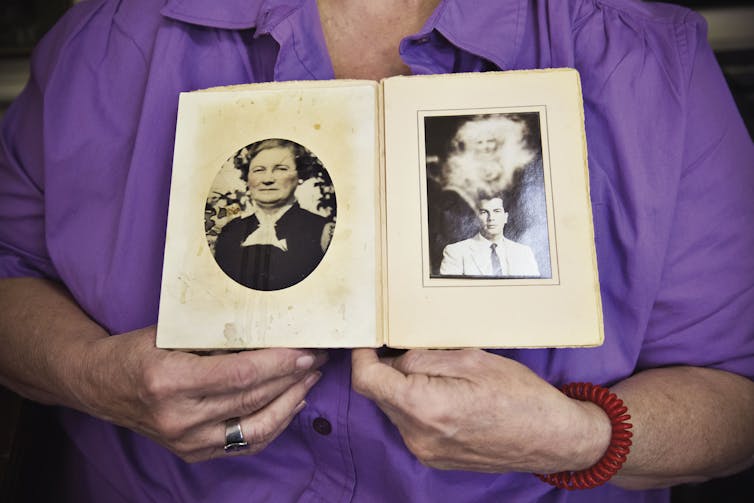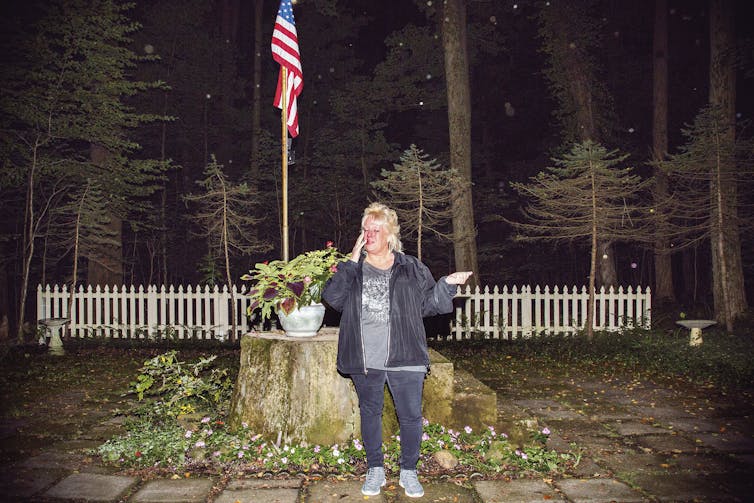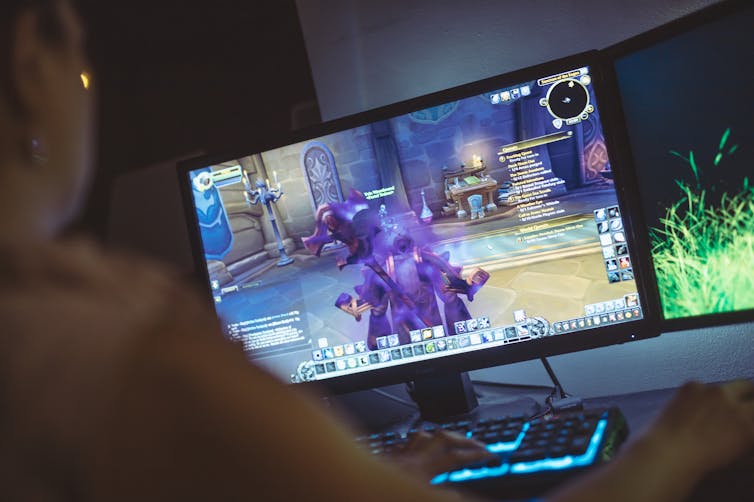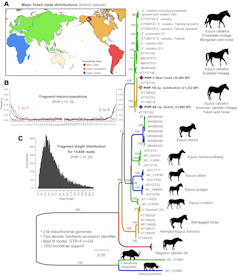Thousands in Ottawa protest COVID mandates, many rebuked
THANKS TO GUN CONTROL
NONE ARE ARMED

1 of 9

1 of 9
Protestors mingle around vehicles parked on Wellington St. in front of West Block and the Parliament buildings as they participate in a cross-country truck convoy protesting measures taken by authorities to curb the spread of COVID-19 and vaccine mandates in Ottawa on Saturday, Jan. 29, 2022.
(Adrian Wyld/The Canadian Press via AP)
OTTAWA, Ontario (AP) — Thousands of protesters gathered in Canada’s capital on Saturday to protest vaccine mandates, masks and lockdowns.
Some parked on the grounds of the National War Memorial and danced on the Tomb of the Unknown Soldier, others carried signs and flags with swastikas and some used the statue of Canadian hero Terry Fox to display an anti-vaccine statement, sparking widespread condemnation.
“I am sickened to see protesters dance on the Tomb of the Unknown Soldier and desecrate the National War Memorial. Generations of Canadians have fought and died for our rights, including free speech, but not this. Those involved should hang their heads in shame,” tweeted Gen. Wayne Eyre, Canada’s Defense Staff chief.
Protestors compared vaccine mandates to fascism, one truck carried a Confederate flag and many carried expletive-laden signs targeting Canadian Prime Minister Justin Trudeau.
The statue of Fox, a national hero who lost a leg to bone cancer as a youngster, then set off in 1980 on a fundraising trek across Canada, was draped with a upside down Canadian flag with a sign that said “mandate freedom.”
Trudeau retweeted a statement from The Terry Fox Foundation that said “Terry believed in science and gave his life to help others.”
Eric Simmons, from Oshawa, Ontario, said all vaccine mandates should be ended.
“They’re not effective, they’re not working. It’s not changing anything. We can’t keep living like this. People are losing their jobs because they don’t want to get the vaccine,” Simmons said.
The convoy of truckers and others prompted police to prepare for the possibility of violence and warn residents to avoid downtown. A top Parliament security official advised lawmakers to lock their doors amid reports their private homes may be targeted.
Trudeau has said Canadians are not represented by this “very troubling, small but very vocal minority of Canadians who are lashing out at science, at government, at society, at mandates and public health advice.″
The prime minister’s itinerary for the day usually says he is in Ottawa if he’s at home, but on Saturday it said “National Capital Region” amid a report he’s been moved to an undisclosed location. One of Trudeau’s kids has COVID-19 and the prime minister has been isolating and working remotely.
Canada has one of the highest vaccination rates in the world and the premier of the province of Quebec who is proposing to tax the unvaccinated is popular.
Some are, in part, protesting a new rule that took effect Jan. 15 requiring truckers entering Canada be fully immunized against the coronavirus. The United States has imposed the same requirement on truckers entering that country.
The Canadian Trucking Alliance said a great number of the protesters have no connection to the trucking industry, adding they have a separate agenda to push. The alliance notes the vast majority of drivers are vaccinated.
The organizers of the protest have called for the forceful elimination of all COVID-19 restrictions and vaccine mandates and some called for the removal of Trudeau.
The Shepherds of Good Hope, which has a soup kitchen for the homeless in Ottawa, reported staff and volunteers “experienced harassment from convoy protestors seeking meals from our soup kitchen. The individuals were given means to defuse the conflict.”
Some opposition Canadian Conservative lawmakers served coffee to the protesters. Conservative party leader Erin O’Toole met with some truckers. The protest has also attracted support from former U.S. President Donald Trump and some Fox News personalities.
“We want those great Canadian truckers to know that we are with them all the way,” Trump said at a rally in Conroe, Texas. “They are doing more to defend American freedom than our leaders by far.”
Former U.S. Ambassador to Canada Bruce Heyman said the threat against democracy isn’t only happening in America.
“Both the use of the swastika and the confederate flag are symbols of hate. So very sad to see these symbols anywhere and especially in Canada,” said Heyman, who was the U.S. envoy under former President Barack Obama.
The Parliamentary Protective Service expects as many as 10,000 protesters as part of a weekend-long rally.
“I’m locked into my own country right now,” said Tom Pappin, an unvaccinated man who came from just outside Ottawa. “I can’t go on a holiday. I can’t go to a restaurant, I can’t go bowling. I can’t go to a movie. You know, these are things that it’s just gotten out of control.”
The 52-year-old said attendees are likely to stay parked by Parliament until vaccine mandates are lifted.
OTTAWA, Ontario (AP) — Thousands of protesters gathered in Canada’s capital on Saturday to protest vaccine mandates, masks and lockdowns.
Some parked on the grounds of the National War Memorial and danced on the Tomb of the Unknown Soldier, others carried signs and flags with swastikas and some used the statue of Canadian hero Terry Fox to display an anti-vaccine statement, sparking widespread condemnation.
“I am sickened to see protesters dance on the Tomb of the Unknown Soldier and desecrate the National War Memorial. Generations of Canadians have fought and died for our rights, including free speech, but not this. Those involved should hang their heads in shame,” tweeted Gen. Wayne Eyre, Canada’s Defense Staff chief.
Protestors compared vaccine mandates to fascism, one truck carried a Confederate flag and many carried expletive-laden signs targeting Canadian Prime Minister Justin Trudeau.
The statue of Fox, a national hero who lost a leg to bone cancer as a youngster, then set off in 1980 on a fundraising trek across Canada, was draped with a upside down Canadian flag with a sign that said “mandate freedom.”
Trudeau retweeted a statement from The Terry Fox Foundation that said “Terry believed in science and gave his life to help others.”
Eric Simmons, from Oshawa, Ontario, said all vaccine mandates should be ended.
“They’re not effective, they’re not working. It’s not changing anything. We can’t keep living like this. People are losing their jobs because they don’t want to get the vaccine,” Simmons said.
The convoy of truckers and others prompted police to prepare for the possibility of violence and warn residents to avoid downtown. A top Parliament security official advised lawmakers to lock their doors amid reports their private homes may be targeted.
Trudeau has said Canadians are not represented by this “very troubling, small but very vocal minority of Canadians who are lashing out at science, at government, at society, at mandates and public health advice.″
The prime minister’s itinerary for the day usually says he is in Ottawa if he’s at home, but on Saturday it said “National Capital Region” amid a report he’s been moved to an undisclosed location. One of Trudeau’s kids has COVID-19 and the prime minister has been isolating and working remotely.
Canada has one of the highest vaccination rates in the world and the premier of the province of Quebec who is proposing to tax the unvaccinated is popular.
Some are, in part, protesting a new rule that took effect Jan. 15 requiring truckers entering Canada be fully immunized against the coronavirus. The United States has imposed the same requirement on truckers entering that country.
The Canadian Trucking Alliance said a great number of the protesters have no connection to the trucking industry, adding they have a separate agenda to push. The alliance notes the vast majority of drivers are vaccinated.
The organizers of the protest have called for the forceful elimination of all COVID-19 restrictions and vaccine mandates and some called for the removal of Trudeau.
The Shepherds of Good Hope, which has a soup kitchen for the homeless in Ottawa, reported staff and volunteers “experienced harassment from convoy protestors seeking meals from our soup kitchen. The individuals were given means to defuse the conflict.”
Some opposition Canadian Conservative lawmakers served coffee to the protesters. Conservative party leader Erin O’Toole met with some truckers. The protest has also attracted support from former U.S. President Donald Trump and some Fox News personalities.
“We want those great Canadian truckers to know that we are with them all the way,” Trump said at a rally in Conroe, Texas. “They are doing more to defend American freedom than our leaders by far.”
Former U.S. Ambassador to Canada Bruce Heyman said the threat against democracy isn’t only happening in America.
“Both the use of the swastika and the confederate flag are symbols of hate. So very sad to see these symbols anywhere and especially in Canada,” said Heyman, who was the U.S. envoy under former President Barack Obama.
The Parliamentary Protective Service expects as many as 10,000 protesters as part of a weekend-long rally.
“I’m locked into my own country right now,” said Tom Pappin, an unvaccinated man who came from just outside Ottawa. “I can’t go on a holiday. I can’t go to a restaurant, I can’t go bowling. I can’t go to a movie. You know, these are things that it’s just gotten out of control.”
The 52-year-old said attendees are likely to stay parked by Parliament until vaccine mandates are lifted.
Canada's 'Freedom Convoy':
Is this Jan. 6 for the Great White North?
Kathryn Joyce, Salon
January 29, 2022

Canada's 'Freedom Convoy' (Screen Grab)
If you choose to believe Fox News and right-wing social media, this weekend a 40-mile long "Freedom Convoy" of 50,000 Canadian truckers, plus millions of their supporters, will converge in Ottawa — our northern neighbor's capital — for a mass protest that will gridlock the city until all of the country's vaccine mandates are repealed
The anti-vaccination convoy movement has raised some $7 million, and earned the support of Canadian conservative Parliament leader Erin O'Toole, who says he plans to meet with the truckers, as well as prominent American conservatives or libertarians from Donald Trump Jr. and Tucker Carlson to Elon Musk. Videos of the convoy have proliferated online, most depicting lines of tractor-trailers driving across Canada, variously set to dramatic film scores or Twisted Sister, and cheered on by throngs of spectators waving the Maple Leaf flag on highway shoulders and overpasses. Other images and videos have popped up too, showcasing the efforts of convoy supporters, including a sort of women's auxiliary unit singing "O Canada" while assembling sandwiches for the truckers.
But in the last couple of days, research and reporting has emerged that suggests the convoy, ripe as it is for gags about the polite or earnest nature of Canadians, could spell trouble. On Friday, Ottawa police asked residents of the city to avoid traveling downtown on Saturday. Security officials at Canada's House of Commons warned that demonstrators have been searching for the home addresses of members of Parliament. Groups that track the far right have warned that the convoy movement is sparking violent rhetoric online, including calls for the demonstration to replicate the U.S. Capitol attack of Jan. 6, 2021, and for drivers to use their trucks to ram into the barricades around the Parliament building.
Reporters and researchers have also pointed out that the convoy movement is inextricably tied to Canadian far-right groups, including members of radical, neo-Nazi-linked "accelerationist" networks, Holocaust deniers and supporters of the white nationalist Great Replacement theory, "sovereign citizen" types with quixotic plans to dissolve the Canadian government and, of course, QAnon adherents.
As one leading Canadian research group, the Canadian Anti-Hate Network (CAHN), noted in an article published Thursday, "Since the start of the pandemic, COVID conspiracies have been bringing various fringe and far-right elements together. The close connections between the People's Party of Canada, the young white supremacists of Canada First, and the Diagolon network is one example. This convoy is another."
On the eve of the convoy's arrival in Ottawa, CAHN's executive director Evan Balgord spoke with Salon.
So what's going on with this convoy?
I'll dispel one myth right away. A lot of folks are saying that this was some sort of trucker convoy that was hijacked by the far right. That's not actually true. Canada was going to have a requirement that cross-border truck drivers get vaccinated. We already have a mandate that some public servants have to be vaccinated, like nurses and doctors, and that's fairly uncontroversial. But a small number of truckers and some trucking organizations pointed out that, because the average Canadian trucker is alone in their trucks all day, why do they have to get vaccinated when they're largely self-isolating because of their work? Agree with it or not, that seems like a reasonable thing to have a conversation about. So the trucking organizations were asking the government to talk about this mandate. And the far right spotted this and just stole it — stole the idea and decided to have a convoy about it.
About two years ago, [the organizers] had another convoy called United We Roll. It was a far-right convoy. It was all the same kind of people that we monitor at CAHN. So they stole this grievance and put together this convoy. We have these organizers on record making Islamophobic statements. One of the loudest, Pat King, has made many racist and antisemitic statements and called for violence in the past. One of the main organizers of the group that's sort of behind the convoy, Canada Unity, is run in part by a guy named James Bauder, who was involved in our Yellow Vest Canada movement. He's previously expressed support for a bunch of different hate groups. He said that [Prime Minister Justin] Trudeau needs to be arrested and charged with treason. He and some other people got together to do this convoy, so it's been a far-right project from day one.
Now their GoFundMe has raised around $7 million, and the actual convoy is about to descend on Ottawa. Of course it's not 50,000 trucks or whatever ridiculous thing Fox News was saying. It's probably 100 to 200 actual trucks and then a bunch of other vehicles. But it's significant. Some people are saying they want it to be Canada's Jan. 6. So it's concerning.
What should people expect to see in Ottawa this weekend?
I'll make one hard prediction. The irony to me in all this is the truckers actually had a kind of issue. But because the far right stole the issue, and the convoy has come to represent far-right extremism, there's no way those truckers or the trucking organizations can have an adult conversation with our government now. They've been totally fucked by this convoy.
If you look at the list of demands that Canada Unity put out in this memorandum of understanding, they're asking that the vaccine passport system and mandates just be done away with across Canada. That's everything from getting on a plane to eating at a restaurant. There's just no way that our government is going to do that. Then they've added on all these other grievances. Some people want to see a Jan. 6. Some people want Trudeau tried for treason. Some people showing up are "sovereign citizens," who believe that using some magic combination of words and pseudo-legal paperwork is going to dissolve the government. And of course, there's the others who are just saying no vaccine mandates whatsoever. None of this is going to happen. So one prediction I'm damn sure of is that they're not going to achieve anything, public policy-wise.
But in terms of what actually happens — it's not like we don't have people who want to do a Jan. 6 here. We do, and they're always around. I don't think something like that is going to happen. Jan. 6 was fairly well planned. Not everybody there was part of that plan, and different groups had different plans, but there was significant planning behind it. I don't know that that planning is taking place here. Then there's the fact that all of our lawmakers and our prime minister aren't actually there right now. And in Ottawa, on Parliament Hill, we have concrete barriers to prevent ramming attacks and a gigantic lawn in front of our Parliament building. All of which, I believe, means it's a lot harder to storm.
But we are telling people who live in Ottawa to stay away this weekend and try not to go outside if they can avoid it. I feel really awful giving that advice. But, you know, there are people among this big convoy who are racists. There are people in this convoy who want to do violence to others. I'm not saying everybody's like that. But they'll be finally reaching their target, the thing they're maddest at, Ottawa, and there's a crowd, there's a mob. So you don't know how things can go.
Maybe there's some violence. Hopefully not. Best-case scenario is just they honk their horns, annoy the hell out of everybody, achieve nothing and then have to go home. A lot of businesses are actually closing up for the day. And there's no public washrooms in Ottawa. They're not going to have anywhere to poop. Sorry to be crass about it. But they're not going to find a warm reception there.
There are a lot of videos online that claim to show hundreds or thousands of trucks on their way to Ottawa. And there are videos claiming to show sympathy protests in different countries around the world. How accurate are the depictions of this movement on social or right-wing media?
I have no idea of anything else happening in other countries. I certainly haven't seen any evidence of that. In terms of people supporting them, for all intents and purposes, this is an anti-vaccine, anti-lockdown crowd. And we've got a lot of them, just like the States has a lot of them, just like many countries have a lot of them. They've thrown all their support behind this, and it's not just a few bad apples, either. Every single hate group, far-right group we monitor is involved in this in some way, shape or form, pretty vocally.
There's very much two Canadas right now. There's the Canada that is for health and public science and all of that. And then there's the far right, which is not. But if anyone's talking about massive levels of support, I'd point out that 90% of our truckers are vaccinated. A lot of our truckers here are South Asian, and I don't see them participating in this convoy in numbers that would be representative. So this isn't about truckers, or the specific issue that truckers had. It's just a far-right thing.
Is this America's fault? Did we do this to you guys?
Not entirely. Canada has had its own unique hate ecosystem forever. What you do in the States does definitely strongly impact us. Of course it does. But it works both ways. I mean, stop me if you've heard the names Gavin McInnes, Lauren Southern, Faith Goldy or Stefan Molyneux before. And you know, AltRight.com, the website, was created in a Toronto apartment; Richard Spencer was living in Toronto at the time. Canada has a disproportionate impact on the States and the rest of the world when it comes to putting out thought leaders in these fascist movements as well. So it's not just the States' fault. We have to own up to our own racist, genocidal history and the systems of white supremacy that we have here as well.
But for American readers, describing the people on the overpasses — they're somewhere between, or an amalgamation of, MAGA and Jan. 6. Meaning, with Jan. 6, there were some people that got really organized and wanted to do what happened, or even worse. And then there were plenty of people who were just there and got swept up and started to participate because somebody lit that match. With the convoy, it's similar: Not everybody that's there is a racist who wants to do violence. But there's elements of that in there. Every single hate group and insurrectionary element that we have in our country is there, or is supporting it from the sidelines. So it does create a volatile situation. I don't think we're quite at critical mass. We don't have all the right ingredients, I think, to make this a Jan. 6. But the point is, there's people here who want it to be.
Kathryn Joyce, Salon
January 29, 2022

Canada's 'Freedom Convoy' (Screen Grab)
If you choose to believe Fox News and right-wing social media, this weekend a 40-mile long "Freedom Convoy" of 50,000 Canadian truckers, plus millions of their supporters, will converge in Ottawa — our northern neighbor's capital — for a mass protest that will gridlock the city until all of the country's vaccine mandates are repealed
The anti-vaccination convoy movement has raised some $7 million, and earned the support of Canadian conservative Parliament leader Erin O'Toole, who says he plans to meet with the truckers, as well as prominent American conservatives or libertarians from Donald Trump Jr. and Tucker Carlson to Elon Musk. Videos of the convoy have proliferated online, most depicting lines of tractor-trailers driving across Canada, variously set to dramatic film scores or Twisted Sister, and cheered on by throngs of spectators waving the Maple Leaf flag on highway shoulders and overpasses. Other images and videos have popped up too, showcasing the efforts of convoy supporters, including a sort of women's auxiliary unit singing "O Canada" while assembling sandwiches for the truckers.
But in the last couple of days, research and reporting has emerged that suggests the convoy, ripe as it is for gags about the polite or earnest nature of Canadians, could spell trouble. On Friday, Ottawa police asked residents of the city to avoid traveling downtown on Saturday. Security officials at Canada's House of Commons warned that demonstrators have been searching for the home addresses of members of Parliament. Groups that track the far right have warned that the convoy movement is sparking violent rhetoric online, including calls for the demonstration to replicate the U.S. Capitol attack of Jan. 6, 2021, and for drivers to use their trucks to ram into the barricades around the Parliament building.
Reporters and researchers have also pointed out that the convoy movement is inextricably tied to Canadian far-right groups, including members of radical, neo-Nazi-linked "accelerationist" networks, Holocaust deniers and supporters of the white nationalist Great Replacement theory, "sovereign citizen" types with quixotic plans to dissolve the Canadian government and, of course, QAnon adherents.
As one leading Canadian research group, the Canadian Anti-Hate Network (CAHN), noted in an article published Thursday, "Since the start of the pandemic, COVID conspiracies have been bringing various fringe and far-right elements together. The close connections between the People's Party of Canada, the young white supremacists of Canada First, and the Diagolon network is one example. This convoy is another."
On the eve of the convoy's arrival in Ottawa, CAHN's executive director Evan Balgord spoke with Salon.
So what's going on with this convoy?
I'll dispel one myth right away. A lot of folks are saying that this was some sort of trucker convoy that was hijacked by the far right. That's not actually true. Canada was going to have a requirement that cross-border truck drivers get vaccinated. We already have a mandate that some public servants have to be vaccinated, like nurses and doctors, and that's fairly uncontroversial. But a small number of truckers and some trucking organizations pointed out that, because the average Canadian trucker is alone in their trucks all day, why do they have to get vaccinated when they're largely self-isolating because of their work? Agree with it or not, that seems like a reasonable thing to have a conversation about. So the trucking organizations were asking the government to talk about this mandate. And the far right spotted this and just stole it — stole the idea and decided to have a convoy about it.
About two years ago, [the organizers] had another convoy called United We Roll. It was a far-right convoy. It was all the same kind of people that we monitor at CAHN. So they stole this grievance and put together this convoy. We have these organizers on record making Islamophobic statements. One of the loudest, Pat King, has made many racist and antisemitic statements and called for violence in the past. One of the main organizers of the group that's sort of behind the convoy, Canada Unity, is run in part by a guy named James Bauder, who was involved in our Yellow Vest Canada movement. He's previously expressed support for a bunch of different hate groups. He said that [Prime Minister Justin] Trudeau needs to be arrested and charged with treason. He and some other people got together to do this convoy, so it's been a far-right project from day one.
Now their GoFundMe has raised around $7 million, and the actual convoy is about to descend on Ottawa. Of course it's not 50,000 trucks or whatever ridiculous thing Fox News was saying. It's probably 100 to 200 actual trucks and then a bunch of other vehicles. But it's significant. Some people are saying they want it to be Canada's Jan. 6. So it's concerning.
What should people expect to see in Ottawa this weekend?
I'll make one hard prediction. The irony to me in all this is the truckers actually had a kind of issue. But because the far right stole the issue, and the convoy has come to represent far-right extremism, there's no way those truckers or the trucking organizations can have an adult conversation with our government now. They've been totally fucked by this convoy.
If you look at the list of demands that Canada Unity put out in this memorandum of understanding, they're asking that the vaccine passport system and mandates just be done away with across Canada. That's everything from getting on a plane to eating at a restaurant. There's just no way that our government is going to do that. Then they've added on all these other grievances. Some people want to see a Jan. 6. Some people want Trudeau tried for treason. Some people showing up are "sovereign citizens," who believe that using some magic combination of words and pseudo-legal paperwork is going to dissolve the government. And of course, there's the others who are just saying no vaccine mandates whatsoever. None of this is going to happen. So one prediction I'm damn sure of is that they're not going to achieve anything, public policy-wise.
But in terms of what actually happens — it's not like we don't have people who want to do a Jan. 6 here. We do, and they're always around. I don't think something like that is going to happen. Jan. 6 was fairly well planned. Not everybody there was part of that plan, and different groups had different plans, but there was significant planning behind it. I don't know that that planning is taking place here. Then there's the fact that all of our lawmakers and our prime minister aren't actually there right now. And in Ottawa, on Parliament Hill, we have concrete barriers to prevent ramming attacks and a gigantic lawn in front of our Parliament building. All of which, I believe, means it's a lot harder to storm.
But we are telling people who live in Ottawa to stay away this weekend and try not to go outside if they can avoid it. I feel really awful giving that advice. But, you know, there are people among this big convoy who are racists. There are people in this convoy who want to do violence to others. I'm not saying everybody's like that. But they'll be finally reaching their target, the thing they're maddest at, Ottawa, and there's a crowd, there's a mob. So you don't know how things can go.
Maybe there's some violence. Hopefully not. Best-case scenario is just they honk their horns, annoy the hell out of everybody, achieve nothing and then have to go home. A lot of businesses are actually closing up for the day. And there's no public washrooms in Ottawa. They're not going to have anywhere to poop. Sorry to be crass about it. But they're not going to find a warm reception there.
There are a lot of videos online that claim to show hundreds or thousands of trucks on their way to Ottawa. And there are videos claiming to show sympathy protests in different countries around the world. How accurate are the depictions of this movement on social or right-wing media?
I have no idea of anything else happening in other countries. I certainly haven't seen any evidence of that. In terms of people supporting them, for all intents and purposes, this is an anti-vaccine, anti-lockdown crowd. And we've got a lot of them, just like the States has a lot of them, just like many countries have a lot of them. They've thrown all their support behind this, and it's not just a few bad apples, either. Every single hate group, far-right group we monitor is involved in this in some way, shape or form, pretty vocally.
There's very much two Canadas right now. There's the Canada that is for health and public science and all of that. And then there's the far right, which is not. But if anyone's talking about massive levels of support, I'd point out that 90% of our truckers are vaccinated. A lot of our truckers here are South Asian, and I don't see them participating in this convoy in numbers that would be representative. So this isn't about truckers, or the specific issue that truckers had. It's just a far-right thing.
Is this America's fault? Did we do this to you guys?
Not entirely. Canada has had its own unique hate ecosystem forever. What you do in the States does definitely strongly impact us. Of course it does. But it works both ways. I mean, stop me if you've heard the names Gavin McInnes, Lauren Southern, Faith Goldy or Stefan Molyneux before. And you know, AltRight.com, the website, was created in a Toronto apartment; Richard Spencer was living in Toronto at the time. Canada has a disproportionate impact on the States and the rest of the world when it comes to putting out thought leaders in these fascist movements as well. So it's not just the States' fault. We have to own up to our own racist, genocidal history and the systems of white supremacy that we have here as well.
But for American readers, describing the people on the overpasses — they're somewhere between, or an amalgamation of, MAGA and Jan. 6. Meaning, with Jan. 6, there were some people that got really organized and wanted to do what happened, or even worse. And then there were plenty of people who were just there and got swept up and started to participate because somebody lit that match. With the convoy, it's similar: Not everybody that's there is a racist who wants to do violence. But there's elements of that in there. Every single hate group and insurrectionary element that we have in our country is there, or is supporting it from the sidelines. So it does create a volatile situation. I don't think we're quite at critical mass. We don't have all the right ingredients, I think, to make this a Jan. 6. But the point is, there's people here who want it to be.


























